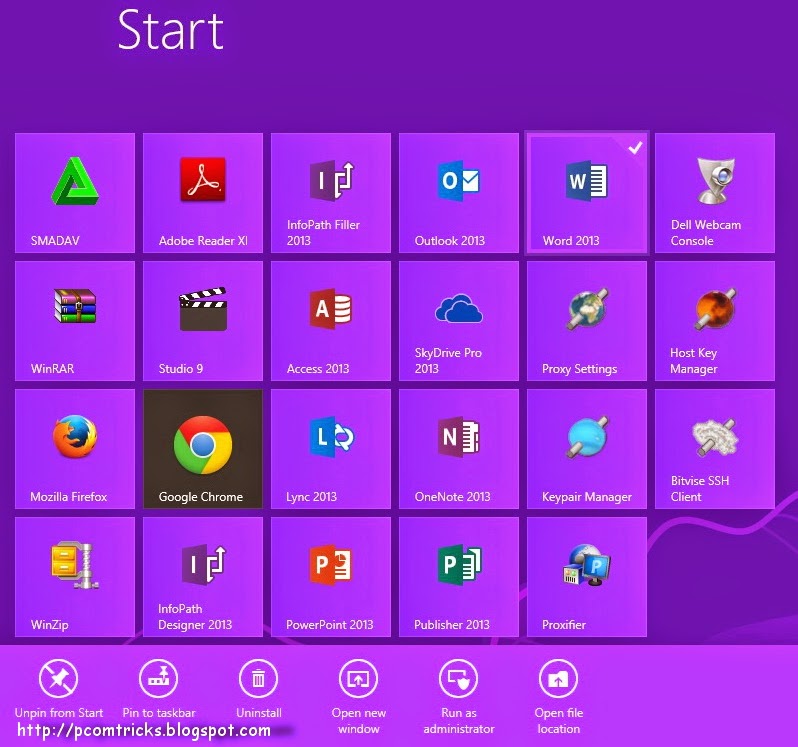

- WINDOWS 8 CREATE APP SHORTCUT PDF
- WINDOWS 8 CREATE APP SHORTCUT INSTALL
- WINDOWS 8 CREATE APP SHORTCUT FULL
- WINDOWS 8 CREATE APP SHORTCUT WINDOWS 8.1
Windows 8.1 is a touch-friendly operating system, though sometimes reaching up to tap the screen isn’t the fastest way to get things done. It costs $5 and has a 30-day trial period. There are several options available, but the best is Start8. To get a more Windows 7-like Start menu back, you’ll have to go with third-party software. Here, you can choose from preset themes and colors or create your own. To change the background image and colors in Desktop mode, right-click anywhere on the desktop and choose Personalize from the menu that pops up. Now the icon will stay even after you close the program. Click “Pin this program to the taskbar” in the menu that comes up. To pin an app to the taskbar, open the program, then right-click (or tap and hold for a second) the icon on the taskbar. In Windows 8.1, there is even a Start Menu, though it doesn’t work quite the same. The Windows 8 Desktop works the same way as Windows 7, including the ability to place program icons anywhere on the desktop and pin icons to the taskbar.
WINDOWS 8 CREATE APP SHORTCUT INSTALL
Look for a similar setting in any other apps that you install in Desktop mode but launch in Windows 8 mode. Chrome will remember your choice after you close the browser and relaunch in the mode you last used. To change this, click the Menu icon (three horizontal lines in upper right corner) and select Relaunch Chrome on the desktop. Google Chrome has both a Desktop and a Windows 8 mode and will load in the latter environment if it’s the default browser. This will work with any file type just download the Desktop app you want to use first.
WINDOWS 8 CREATE APP SHORTCUT PDF
To change this, find a PDF file in the File Explorer, right-click, then choose Open With > Choose Default Program… > Adobe Reader. To avoid this, change file and program defaults.Īs an example, the Reader app in Windows 8 opens PDF files by default, even if you download Adobe Reader XI. Also, some programs work in both environments and might open in touch mode at first. Most of the time, this will happen because the default program for opening a file (photos, PDF documents, etc.) is a Windows 8 app. Staying in the DesktopĮven with this setting on, your PC might still enter the Windows Store App environment under some circumstances. Now when you boot Windows or when you close a program, the PC will default to the Desktop and not the Start screen. Under Start screen, check the “When I sign in or close all apps on a screen, go to the desktop instead of Start” option, then OK. Right-click the taskbar at the bottom (or tap and hold there for a second to bring up the menu), and click Properties > Navigation. On the Start screen, find the Desktop icon and tap it to switch. If you end up spending most of your time using Desktop apps, you’ll want to take some steps to remain in Desktop mode as you work and even bypass the Start screen, starting up directly into Desktop. So once you’ve set up your computer, spend some time using both types of apps. You can split the window to see two apps side by side, but you can’t tile four or five apps the way you can in Desktop.īoth Desktop and Windows Store apps can be launched from the Start screen. Also, in Desktop mode each program operates in a distinct window that can be moved around, resized and minimized (again, like Windows 7). The biggest difference between Desktop apps and Windows Store apps is that the latter tend to be more touch-friendly, while Desktop apps have smaller menus and icons, so it’s more comfortable to use a mouse. With Windows 8.1, you can skip seeing the Start screen altogether.

If you prefer this mode to Metro, it’s possible to work only or mainly in the Desktop. If you install programs you used on previous versions of Windows ( XP, Vista or 7), they will open in the Desktop environment.

WINDOWS 8 CREATE APP SHORTCUT FULL
Follow 8 has two environments: the full screen, touch-centric Windows Store App interface (also called Metro) and the Desktop interface, which looks and acts like Windows 7.


 0 kommentar(er)
0 kommentar(er)
